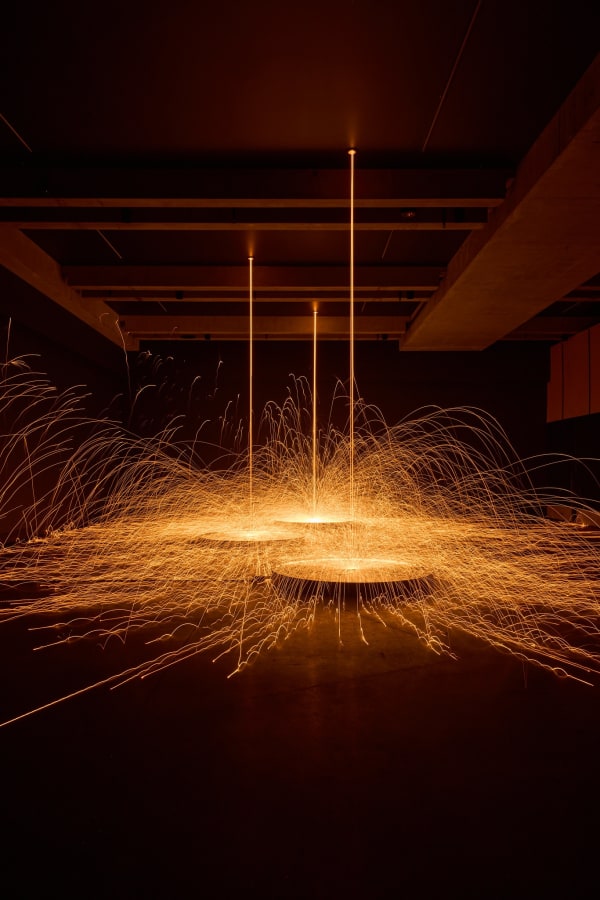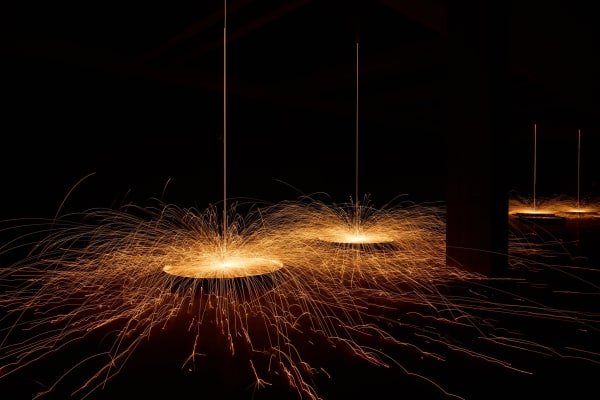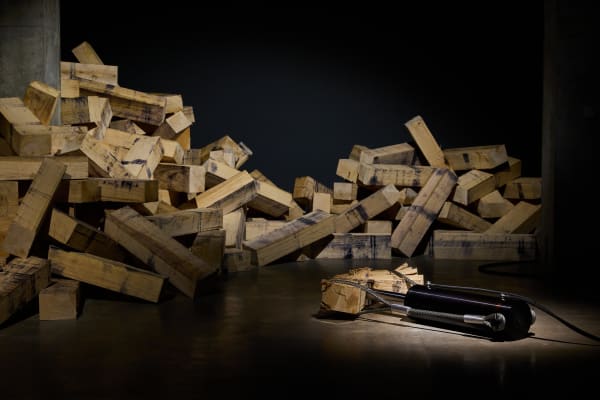Arcangelo Sassolino: in the end, the beginning: MONA
-

Including: the paradoxical nature of life, 2018
Photo credit: Jesse Hunniford
Image courtesy Museum of Old and New Art, Hobart, Tasmania, Australia
-

Photo credit: Jesse Hunniford
Image courtesy Museum of Old and New Art, Hobart, Tasmania, Australia
-

Photo credit: Jesse Hunniford
Image courtesy Museum of Old and New Art, Hobart, Tasmania, Australia
-

Photo credit: Jesse Hunniford
Image courtesy Museum of Old and New Art, Hobart, Tasmania, Australia
-

Photo credit: Jesse Hunniford
Image courtesy Museum of Old and New Art, Hobart, Tasmania, Australia
-

Photo credit: Jesse Hunniford
Image courtesy Museum of Old and New Art, Hobart, Tasmania, Australia
-

Photo credit: Jesse Hunniford
Image courtesy Museum of Old and New Art, Hobart, Tasmania, Australia
-

Photo credit: Jesse Hunniford
Image courtesy Museum of Old and New Art, Hobart, Tasmania, Australia
-

marcus, 2018
Photo credit: Jesse Hunniford
Image courtesy Museum of Old and New Art, Hobart, Tasmania, Australia
-

Photo credit: Jesse Hunniford
Image courtesy Museum of Old and New Art, Hobart, Tasmania, Australia
-

Photo credit: Jesse Hunniford
Image courtesy Museum of Old and New Art, Hobart, Tasmania, Australia
The Museum of Old and New Art (Mona) has today unveiled Italian sculptor Arcangelo Sassolino’s first solo exhibition in Australia, on display until 6 April 2026. From dripping metal to splintering wood, in the end, the beginning features a selection of kinetic sculptures that push matter to their edges, and coincides with the first week of Dark Mofo, as Tasmania’s midwinter solstice festival returns in full.
The exhibition’s title piece, in the end, the beginning, sees one of Mona’s subterranean galleries showered with molten steel. Heated to 1500°C, the liquid metal creates dramatic firelight sparks as it drips down from the ceiling. This work is a reimagining of the artist’s renowned installation Diplomazija astuta, originally created for the Malta Pavilion at the 2022 Venice Biennale, where Sassolino used the light of melted steel to evoke the chiaroscuro in Caravaggio’s 1608 altarpiece painting The Beheading of Saint John the Baptist.
Sassolino has scaled up his interest in mechanics and technology, creating dynamic sculptures that test the laws of physics. Known for complex kinetic works, automata and installations, he uses force, tension, speed, heat and gravityto create dramatic transformations in his—often industrial—materials, along with a sense of danger and suspense. The persistent effort required to sustain existence is an intrinsic element of his work. All Sassolino’s sculptures incorporate a sort of countdown mechanism, reinforcing a reflection on time as an integral part of the experience, heightening anticipation and emphasising the ephemeral nature of material states and motion.
At Mona, Sassolino presents five additional sculptures alongside in the end, the beginning that highlight his relentless exploration of matter and its physical limits. This includes violenza casuale, a work in which wooden beams, bound by steel cables, are continuously crushed by hydraulic pressure causing them to splinter and disintegrate. A similar interplay of tension and fragility is seen in the paradoxical nature of life where a pane of glass bows under the weight of a large boulder. The sculpture marcus shows a tyre squeezed and warped out of shape, while no memory without loss features two three-metre discs slowly rotating on the wall, trickling industrial oil down the centre of the disc.
Director of Curatorial Affairs at Mona, Jarrod Rawlins says: ‘Arcangelo creates rooms filled with tension while somehow maintaining a heightened state of peacefulness. The possibility that an artwork could at any moment create havoc or simply explode under pressure is a beautiful thing. It’s the type of art that comforts me. Come and have a look.’
Arcangelo Sassolino says: ‘Reimagining the installation created for Venice as a site-specific work for Mona has been a demanding challenge. In in the end, the beginning, I take another step toward freeing matter from a predetermined form, allowing it to become time itself. Mona is the perfect place for this transformation—it is a space that not only embraces the raw energy released by materials but also highlights how that energy dissipates into the surrounding space. My fascination has always been with pushing materials beyond their limits, revealing their breaking points, their resistance, their impermanence. Working at this scale means confronting the forces that shape matter, but also the forces that dissolve it.’
Exhibition details:
in the end, the beginning is presented at Mona until 6 April 2026.
About Arcangelo Sassolino
Arcangelo Sassolino (born 1967 in Montecchio Maggiore, Italy) currently lives and works in Vicenza, Italy. Sassolino’s work is the result of a close dialogue between art and physics. His interest in mechanics and technology opens up new meanings and possibilities for sculpture. Speed, pressure, gravity, acceleration and heat are the core of his artistic practice, which is always aimed at pushing the ultimate limit of matter’s resistance. Sassolino’s works usually
consist of devices that generate inorganic performances. The materials involved, often industrial, come alive revealing contrasts and opposing forces. His works embody intrinsic conflicts and push us to contemplate the risk ofthe work’s collapse as a fundamental part of its experience. By exploring different states of matter, Sassolino’s works manifest a level of tension, suspension, unpredictability and danger. Insofar as failure is always a concrete possibility, his works materially embed an inescapable aspect of the human condition.
Sassolino’s work has been the subject of several solo exhibitions, at Contemporary Art Museum, St. Louis; Frankfurter Kunstverein, Frankfurt; Palais de Tokyo, Paris; Museo MACRO, Rome; Z33 House for Contemporary Art, Hasselt; Académie de France – Villa Medici, Rome; and Arte Sella, Borgo Valsugana, Trento; and in art galleries at Galleria Continua, San Gimignano/Paris; Galleria dello Scudo, Verona; and Repetto Gallery, London. Sassolino’s work
has been also featured in a number of group exhibitions, at 2nd Islamic Arts Biennale in Jeddah, 59th International Art Exhibition, La Biennale di Venezia, Malta Pavilion, Venice; Fondation Carmignac, Île de Porquerolles; Spazi Capaci, Palermo; Kunstmuseum Bonn, Bonn; 17th International Architecture Exhibition, La Biennale di Venezia, Venice; Grand Palais, Paris; Kunstverein Hannover, Hannover; Broad Art Museum, East Lansing; Palazzo Ducale, Venice;
Fundación Pablo Atchugarry, Punta del Este; Le Centquatre-Paris, Paris; CCC Strozzina, Florence; Museo MART, Rovereto; Art and The City, Zurich; Swiss Institute, New York; Tinguely Museum, Basel; Peggy Guggenheim Collection, Venice; Dunkers Kulturhus, Helsingborg; FRAC Museum Regional, Reims; ZKM, Karlsruhe; and Fondazione Bevilacqua La Masa, Venice.












